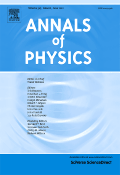
Annals of Physics
Scope & Guideline
Fostering innovation and excellence in scientific research.
Introduction
Aims and Scopes
- Quantum Field Theory and Quantum Mechanics:
Research in this area includes advanced topics like quantum measurements, decoherence, and quantum tunneling, emphasizing theoretical frameworks and experimental validations. - Gravitation and Cosmology:
This scope encompasses studies on black holes, wormholes, and cosmological models, exploring fundamental questions about the universe's structure and evolution. - Particle Physics and High-Energy Physics:
The journal publishes works related to the Standard Model, beyond the Standard Model theories, and phenomena related to particle interactions and decays. - Statistical Mechanics and Thermodynamics:
Research in this area deals with thermodynamic properties, phase transitions, and statistical approaches to quantum systems, highlighting the interplay between microscopic and macroscopic phenomena. - Mathematical Physics and Theoretical Models:
This includes the development of new mathematical techniques and theoretical models that provide insights into physical systems, often leading to novel predictions and applications. - Nonlinear Dynamics and Complex Systems:
The journal explores complex systems, including those with nonlinear interactions, providing insights into phenomena such as chaos and emergent behavior. - Topological and Quantum Materials:
Research in this area focuses on topological phases, quantum materials, and their implications for condensed matter physics, including exotic states of matter.
Trending and Emerging
- Quantum Gravity and Black Hole Physics:
Recent publications have increasingly focused on quantum gravity theories, black hole thermodynamics, and the implications of quantum mechanics in gravitational contexts, reflecting a growing interest in unifying quantum mechanics and general relativity. - Dark Matter and Dark Energy Models:
There is a notable increase in research regarding dark matter and dark energy, with innovative theoretical frameworks and models being proposed to address these fundamental mysteries in cosmology. - Topological Phases and Quantum Materials:
Research on topological insulators, quantum Hall effects, and related phenomena is gaining traction, reflecting the burgeoning interest in materials with nontrivial topological properties. - Nonlinear Dynamics and Complex Systems:
Emerging studies in nonlinear dynamics and complex systems highlight their relevance in various physical contexts, including quantum systems and condensed matter. - Interdisciplinary Approaches to Quantum Information:
There is a rising trend in interdisciplinary research that combines quantum mechanics with information theory, focusing on quantum computing, entanglement, and quantum communication protocols. - Advancements in Quantum Field Theory:
New techniques and models in quantum field theory are emerging, particularly in the context of exploring non-Hermitian systems and exotic interactions, reflecting a vibrant area of theoretical research.
Declining or Waning
- Classical Mechanics and Relativity:
There has been a noticeable decrease in papers focused on classical mechanics and traditional aspects of relativity, possibly due to the growing emphasis on quantum and relativistic effects in modern physics. - Experimental Techniques in Traditional Physics:
Papers detailing classical experimental techniques have diminished, as the focus shifts toward more innovative and interdisciplinary experimental methodologies involving quantum systems. - Nonrelativistic Quantum Mechanics:
Research concentrating on nonrelativistic quantum mechanics appears to be waning, with more emphasis now on relativistic quantum fields and their applications. - Standard Cosmological Models:
Traditional studies of cosmological models without incorporating new physics or modifications are becoming less frequent, as the field moves towards exploring dark energy, modified gravity, and more complex models. - Classical Thermodynamics:
There is a decline in works focusing solely on classical thermodynamics, with a shift towards quantum thermodynamics and statistical mechanics.
Similar Journals
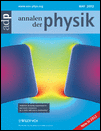
ANNALEN DER PHYSIK
A Legacy of Excellence in Scientific DiscourseANNALEN DER PHYSIK, a prestigious journal published by WILEY-V C H VERLAG GMBH, stands as a cornerstone of the field of physics and astronomy since its inception in 1799. With an ISSN of 0003-3804 and an E-ISSN of 1521-3889, this journal provides a platform for innovative research and critical discourse across various domains of physics. Annalen der Physik is currently ranked in the Q2 category for general physics and astronomy, occupying rank #76 out of 243 in Scopus, placing it within the 68th percentile. This indicates its significant impact and the quality of research it publishes. Although the journal does not offer Open Access options, its robust historical lineage and ongoing contributions ensure that it continues to be an essential resource for researchers, professionals, and students alike. For those seeking to stay at the forefront of contemporary physics research, ANNALEN DER PHYSIK represents a vital source of knowledge, innovation, and scholarly communication.
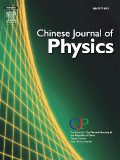
CHINESE JOURNAL OF PHYSICS
Elevating Knowledge in Physics and AstronomyCHINESE JOURNAL OF PHYSICS is a distinguished publication in the field of physics, published by Elsevier. With its roots in Taiwan, this journal has been a vital platform for disseminating innovative research findings since its convergence in 1996, and it continues to thrive, with articles contributing to the advancement of physics and astronomy until 2024. The journal is recognized for its high quality, achieving a notable Q2 ranking in the Physics and Astronomy category, positioning it among the top 30 out of 243 journals in its field, reflecting an impressive 87th percentile ranking. Although it does not operate under an open access model, the journal offers valuable insights into the latest trends and developments in general physics and astronomy, making it an essential resource for researchers, professionals, and students dedicated to advancing their knowledge and understanding of these dynamic fields. With a commitment to rigorous peer review and a diverse range of articles, the CHINESE JOURNAL OF PHYSICS is instrumental in fostering collaboration and innovation within the global scientific community.
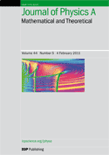
Journal of Physics A-Mathematical and Theoretical
Bridging Theory and Application in Mathematical PhysicsThe Journal of Physics A-Mathematical and Theoretical, published by IOP Publishing Ltd, is a premier peer-reviewed journal dedicated to advancing the understanding of mathematical physics, modeling, and simulation methods within the dynamic field of physics and astronomy. Established in the United Kingdom, this journal has made significant contributions over the years, maintaining a strong reputation as a Q1 and Q2 ranked journal across various categories, reflecting its influence in the scientific community. With a focus on innovative and theoretical approaches, it provides a platform for researchers, professionals, and students to disseminate their findings and engage with groundbreaking methodologies. Despite its lack of open access options, the journal's high impact factor and Scopus rankings, which place it in the top percentiles across multiple disciplines, underscore its critical role in fostering scholarly communication and collaboration in mathematical and theoretical physics. As we move through its converged years from 2007 to 2024, the Journal of Physics A continues to be a pivotal contributor to the landscape of contemporary physics, stimulating discussions and advancing knowledge in an ever-evolving realm.
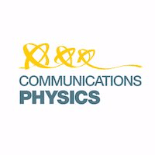
Communications Physics
Illuminating the path of interdisciplinary collaboration.Communications Physics is a premier open access journal published by Nature Portfolio, dedicated to disseminating high-quality research in the field of Physics and Astronomy. Since its inception in 2018, the journal has rapidly established itself as a vital platform for innovative scientific communication, boasting an impressive Impact Factor and achieving Q1 status in the 2023 category of Physics and Astronomy (miscellaneous). With a Scopus rank of #31 out of 243, placing it within the 87th percentile, Communications Physics attracts a global audience of researchers, professionals, and students eager to engage with cutting-edge findings. The journal supports open access, ensuring that research is freely available to the public, which enhances its visibility and encourages broader discussions within the scientific community. Located in Berlin, Germany, Communications Physics aims to bridge the gap between various disciplines within physics, fostering interdisciplinary collaboration and inspiring future research endeavors.
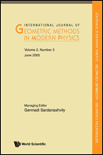
INTERNATIONAL JOURNAL OF GEOMETRIC METHODS IN MODERN PHYSICS
Advancing Theoretical Insights Through GeometryINTERNATIONAL JOURNAL OF GEOMETRIC METHODS IN MODERN PHYSICS is a leading academic publication dedicated to the interdisciplinary exploration of geometric methods in the realms of modern physics. Published by WORLD SCIENTIFIC PUBL CO PTE LTD, this esteemed journal is based in Singapore and acts as a critical platform for researchers, professionals, and students seeking to delve into the intricacies of modern theoretical physics and its geometric foundations. With an impressive Scopus ranking placing it in the 64th percentile of its category, the journal highlights innovative research and developments from 2005 to 2024 within its scope. While currently not offering Open Access, it remains a vital resource for the dissemination of valuable knowledge in its field, contributing significantly to the advancement of physics and astronomy. We encourage the academic community to explore this exceptional journal for cutting-edge insights and to further enhance their understanding of geometric applications in modern scientific inquiry.

Physical Review Research
Advancing the frontiers of physics and astronomy.Physical Review Research, published by the American Physical Society, is a premier open access journal dedicated to the dissemination of high-quality research across all areas of physics and astronomy. Since its inception in 2019, this journal has quickly established itself as a vital platform for researchers, achieving a prestigious Q1 ranking in the dynamics of Physics and Astronomy (miscellaneous) and holding a commendable position in the Scopus Rankings with a rank of #29 out of 243, placing it in the 88th percentile. With the commitment to fostering scientific collaboration and transparency, Physical Review Research offers unrestricted access to valuable findings, enabling researchers, professionals, and students alike to engage with cutting-edge contributions in general physics and astronomy. As it converges into its forthcoming years of publication, the journal remains dedicated to showcasing rigorous research and innovative ideas that drive the field forward.
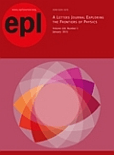
EPL
Exploring New Horizons in Scientific ResearchEPL, a prominent journal published by IOP Publishing Ltd, stands at the forefront of the field of Physics and Astronomy. With a history of impactful contributions stretching from 1986 to 2024, EPL serves as a dynamic platform for researchers to disseminate their pioneering findings and innovative ideas. The journal, with a current category ranking of Q2 among its peers and a competitive Scopus rank of #101 out of 243 in the general physics and astronomy category, reflects its substantial reputation and contribution to the scientific community. Although it operates under a traditional subscription model, EPL's reach is extensive, enabling access to a diverse readership that includes academicians, industry professionals, and students alike. By fostering interdisciplinary collaboration and promoting rigorous research, EPL continues to play a vital role in shaping the future of physics and astronomy.

THEORETICAL AND MATHEMATICAL PHYSICS
Elevating Research in Mathematical Models and FrameworksTHEORETICAL AND MATHEMATICAL PHYSICS, published by MAIK NAUKA/INTERPERIODICA/SPRINGER, is a premier journal dedicated to advancing the fields of Mathematical Physics and Statistical and Nonlinear Physics. With an impressive history spanning from 1969 to 2024, this journal serves as a vital platform for researchers, professionals, and students eager to explore cutting-edge theoretical frameworks and mathematical models. Although it currently holds a Q3 ranking in both its categories as per the 2023 metrics and is positioned within the Scopus ranks reflecting its growing influence, the journal continually aims to enhance its impact within the academic community. The publication does not currently provide open-access options, underscoring its collector’s nature in the dissemination of valuable research findings. Submissions are welcomed from diverse areas of theoretical physics, providing a rich and collaborative environment for the exploration of complex phenomena and the development of innovative methodologies.
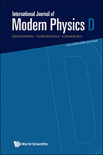
INTERNATIONAL JOURNAL OF MODERN PHYSICS D
Charting New Territories in Scientific UnderstandingWelcome to the INTERNATIONAL JOURNAL OF MODERN PHYSICS D, a premier publication dedicated to the advancement of knowledge in the fields of Astronomy and Astrophysics, Mathematical Physics, and Space and Planetary Science. Published by WORLD SCIENTIFIC PUBL CO PTE LTD in Singapore, the journal boasts an impressive impact, being ranked Q2 in Astronomy and Astrophysics and Mathematical Physics, and Q3 in Space and Planetary Science. With a converged publishing timeline from 1996 to 2024, this journal provides a vital platform for researchers and professionals to disseminate their findings, engage with cutting-edge research, and explore emerging ideas in modern physics. Although it operates under a traditional access model, the rigorous peer-reviewed process ensures that only the highest quality research contributes to the collective understanding of our universe. Join us in advancing the frontiers of physics and astronomy!
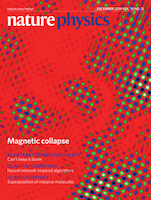
Nature Physics
Transforming Theoretical Insights into Practical ApplicationsNature Physics is a premier journal dedicated to publishing high-impact research in the realm of physics, brought to you by the esteemed NATURE PORTFOLIO. With its ISSN 1745-2473 and E-ISSN 1745-2481, this journal has established itself as a vital resource for the physics community, enjoying a remarkable Q1 quartile ranking in the Physics and Astronomy category for 2023 and securing an impressive Rank #5/243 and a 98th percentile ranking in Scopus. Since its inception in 2005, Nature Physics has become a catalyst for innovation, featuring cutting-edge research that encompasses a broad spectrum of physics disciplines. Although it operates under traditional subscription models, it maintains a commitment to accessibility through selective publications and editorial excellence. Positioned in Berlin, Germany, this journal is a must-read for researchers, professionals, and students who seek to stay at the forefront of advancements in physics.